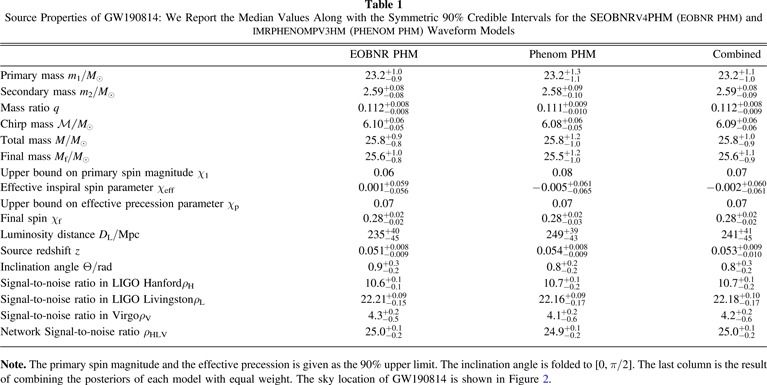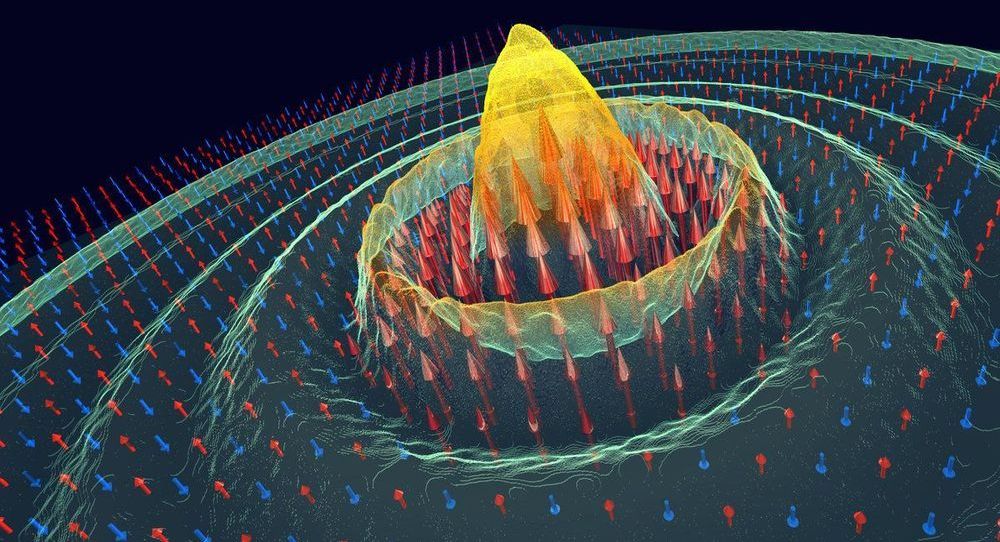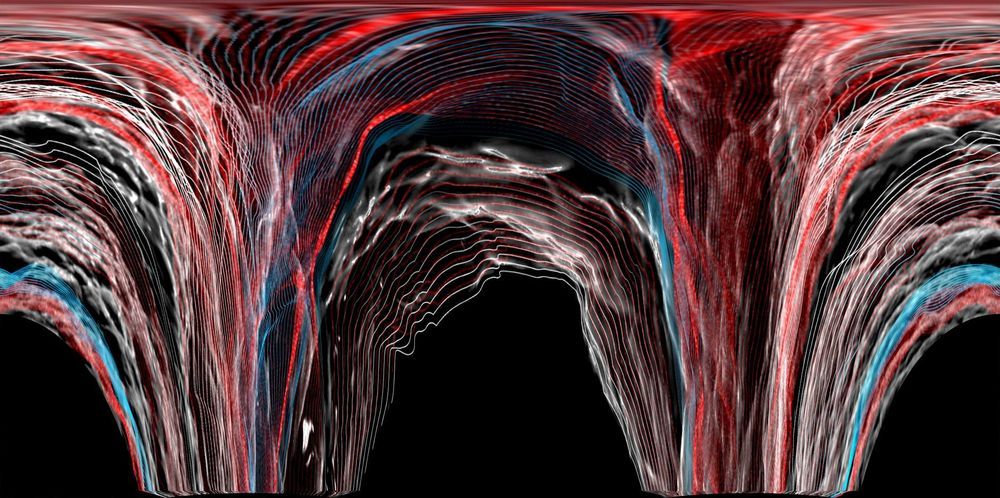In an experiment performed at Lawrence Berkeley National Laboratory’s 88-inch cyclotron, a team of physicists successfully created a new isotope of the human-made element mendelevium.


In an experiment performed at Lawrence Berkeley National Laboratory’s 88-inch cyclotron, a team of physicists successfully created a new isotope of the human-made element mendelevium.

A 50-year-old theoretical process for extracting energy from a rotating black hole finally has experimental verification.
Using an analogue of the components required, physicists have shown that the Penrose process is indeed a plausible mechanism to slurp out some of that rotational energy — if we could ever develop the means.
That’s not likely, but the work does show that peculiar theoretical ideas can be brilliantly used to explore the physical properties of some of the most extreme objects in the Universe.

Intensity is rising at CERN. In the superconducting equipment testing hall, an innovative transmission line has set a new record for the transport of electricity. The link, which is 60 metres long, has transported a total of 54 000 amperes (54 kA, or 27 kA in either direction). “It is the most powerful electrical transmission line built and operated to date!” says Amalia Ballarino, the designer and project leader.
The line has been developed for the High-Luminosity LHC (HL-LHC), the accelerator that will succeed the Large Hadron Collider (LHC) and is scheduled to start up at the end of 2027. Links like this one will connect the HL-LHC’s magnets to the power converters that supply them.
The secret to the new line’s power can be summarised in one word: superconductivity.

R. Abbott 1, T. D. Abbott 2, S. Abraham 3, F. Acernese 4,5, K. Ackley 6, C. Adams 7, R. X. Adhikari 1, V. B. Adya 8, C. Affeldt 9,10, M. Agathos 11,12, K. Agatsuma13, N. Aggarwal 14, O. D. Aguiar 15, A. Aich 16, L. Aiello 17,18, A. Ain 3, P. Ajith 19, S. Akcay 11,20, G. Allen 21, A. Allocca 22, P. A. Altin 8, A. Amato 23, S. Anand 1, A. Ananyeva 1, S. B. Anderson 1, W. G. Anderson 24, S. V. Angelova 25, S. Ansoldi 26,27, S. Antier 28, S.

An element that could hold the key to the long-standing mystery around why there is much more matter than antimatter in our universe has been discovered in Physics research involving the University of Strathclyde.
The study has discovered that an isotope of the element thorium possesses the most pear-shaped nucleus yet to be discovered.
Nuclei similar to thorium-228 may now be able to be used to perform new tests to try find the answer to the mystery surrounding matter and antimatter.

Magnetic materials have been a mainstay in computing technology due to their ability to permanently store information in their magnetic state. Current technologies are based on ferromagnets, whose states can be flipped readily by magnetic fields. Faster, denser, and more robust next-generation devices would be made possible by using a different class of materials, known as antiferromagnets. Their magnetic state, however, is notoriously difficult to control.
Now, a research team from the MPSD and the University of Oxford has managed to drive a prototypical antiferromagnet into a new magnetic state using terahertz frequency light. Their groundbreaking method produced an effect orders of magnitude larger than previously achieved, and on ultrafast time scales. The team’s work has just been published in Nature Physics.
The strength and direction of a magnet’s ‘north pole’ is denoted by its so-called magnetization. In ferromagnets, this easily reversible magnetization can represent a ‘bit’ of information, which has made them the materials of choice for magnet-based technologies. But ferromagnets are slow to operate and react to stray magnetic fields, which means they are prone to errors and cannot be packed very closely together.
Massive object cannot be explained without changing our understanding of what we know about astrophysics, researchers say.

Every year, 2 million black hole mergers are missed — Australian scientists work out how to detect them, revealing a lost 8 billion light-years of Universe evolution.
Last year, the Advanced LIGO –VIRGO gravitational-wave detector network recorded data from 35 merging black holes and neutron stars. A great result — but what did they miss? According to Dr. Rory Smith from the ARC Centre of Excellence in Gravitational Wave Discovery at Monash University in Australia — it’s likely there are another 2 million gravitational wave events from merging black holes, “a pair of merging black holes every 200 seconds and a pair of merging neutron stars every 15 seconds” that scientists are not picking up.
Dr. Smith and his colleagues, also at Monash University, have developed a method to detect the presence of these weak or “background” events that to date have gone unnoticed, without having to detect each one individually. The method — which is currently being test driven by the LIGO community — “means that we may be able to look more than 8 billion light-years further than we are currently observing,” Dr. Smith said.

Surrogate models supported by neural networks can perform as well, and in some ways better, than computationally expensive simulators and could lead to new insights in complicated physics problems such as inertial confinement fusion (ICF), Lawrence Livermore National Laboratory (LLNL) scientists reported.
In a paper published by the Proceedings of the National Academy of Sciences (PNAS), LLNL researchers describe the development of a deep learning-driven Manifold & Cyclically Consistent (MaCC) surrogate model incorporating a multi-modal neural network capable of quickly and accurately emulating complex scientific processes, including the high-energy density physics involved in ICF.
The research team applied the model to ICF implosions performed at the National Ignition Facility (NIF), in which a computationally expensive numerical simulator is used to predict the energy yield of a target imploded by shock waves produced by the facility’s high-energy laser. Comparing the results of the neural network-backed surrogate to the existing simulator, the researchers found the surrogate could adequately replicate the simulator, and significantly outperformed the current state-of-the-art in surrogate models across a wide range of metrics.

Last year, the Advanced LIGO-VIRGO gravitational-wave detector network recorded data from 35 merging black holes and neutron stars. A great result—but what did they miss? According to Dr. Rory Smith from the ARC Centre of Excellence in Gravitational Wave Discovery at Monash University in Australia—it’s likely there are another 2 million gravitational wave events from merging black holes, “a pair of merging black holes every 200 seconds and a pair of merging neutron stars every 15 seconds” that scientists are not picking up.
Dr. Smith and his colleagues, also at Monash University, have developed a method to detect the presence of these weak or “background” events that to date have gone unnoticed, without having to detect each one individually. The method—which is currently being test driven by the LIGO community—” means that we may be able to look more than 8 billion light years further than we are currently observing,” Dr. Smith said.
“This will give us a snapshot of what the early universe looked like while providing insights into the evolution of the universe.”